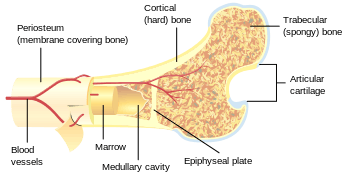Cortical bone
| Cortical bone | |
|---|---|
 Cross-section of a bone showing both cortical bone (at top center) and cancellous bone (at top right, as trabecular bone) | |
| Details | |
| Identifiers | |
| Latin | substantia corticalis, substantia compacta |
| TA | A02.0.00.002 |
| FMA | 24018 |
Cortical bone, synonymous with compact bone, is one of the two types of osseous tissue that form bones. Cortical bone facilitates bone's main functions: to support the whole body, protect organs, provide levers for movement, and store and release chemical elements, mainly calcium. As its name implies, cortical bone forms the cortex, or outer shell, of most bones. Again, as its name implies, compact bone is much denser than cancellous bone, which is the other type of osseous tissue. Furthermore, it is harder, stronger and stiffer than cancellous bone. Cortical bone contributes about 80% of the weight of a human skeleton. The primary anatomical and functional unit of cortical bone is the osteon.
See also
References
- Netter, Frank H. (1987), Musculoskeletal system: anatomy, physiology, and metabolic disorders. Summit, New Jersey: Ciba-Geigy Corporation ISBN 0-914168-14-2
External links
| Wikimedia Commons has media related to Cortical bone. |
This article is issued from Wikipedia - version of the 10/20/2016. The text is available under the Creative Commons Attribution/Share Alike but additional terms may apply for the media files.